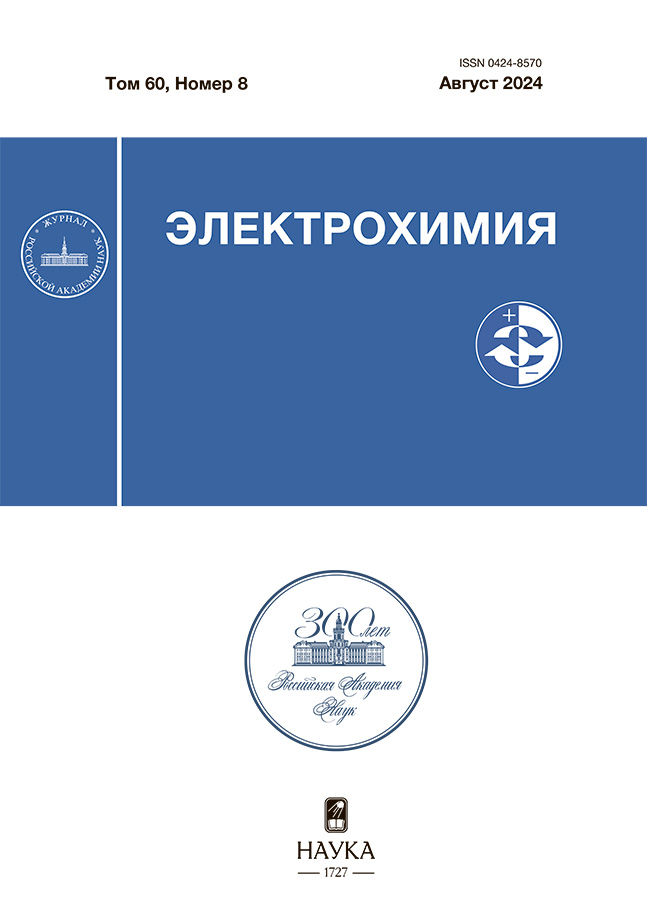Volume 60, Nº 8 (2024)
- Ano: 2024
- Artigos: 6
- URL: https://medjrf.com/0424-8570/issue/view/12372
Edição completa
Articles
Application of Square-Wave Stripping Voltammetry for the Analysis of Electrodeposits Based on Lead-Bismuth
Resumo
The possibility of targeted electrodeposition of coatings in the lead-bismuth binary system is discussed. The analysis of metal content in electrodeposits was performed using square-wave stripping voltammetry of solutions simultaneously containing lead and bismuth. The obtained results were supported by scanning electron microscopy, energy-dispersive X-ray spectroscopy, and powder X-ray diffraction analysis. The electrodeposition conditions of obtaining Pb7Bi3 ε-phase, which is promising for the application in superconducting microelectronics, were found.
 530-538
530-538


Deposition of Iron Doped Birnessite During Simultaneous Electroreduction of Permanganate and Ferrate(Vi) In Sodium Hydroxide Solution
Resumo
The reduction of permanganate on rotating disk electrode is accompanied by inhibition of precipitating birnessite. Addition of potassium ferrate(VI) leads to an increase of inhibition. The obtaining of electrode material based on Fe-doped birnessite under alkaline conditions is demonstrated in experiment with deposition at inhibition potentials. This birnessite is single-phase and highly disordered. Fe content varies from 0 to 10 mol. % in respect to Mn with increasing ferrate(VI) content in deposition solution. Recharging potentials of birnessite are shifted which is manifested by cyclic voltammetry. Doping allows to increase the rate of oxygen evolution reaction. Specific currents are increased with the iron content in birnessite. The Tafel slope is 53 mV/dec and decreased by 2.5 times for birnessite containing 10 mol. % Fe.
 539-552
539-552


Polysulfone-Based Anion-exchange Membranes for Alkaline Water Electrolyzers
Resumo
By the method of chloromethylation and further quaternization of polysulfone, the synthesis of an anion-exchange membrane for electrolyzers of water with an alkaline electrolyte was carried out. The characteristics of the resulting membrane are determined: porosity, electrical conductivity, gas density. A comparative analysis of the characteristics of the membrane and the porous diaphragm (analog of ZifronPerl) is given, the results of tests in the composition of an alkaline electrolyzer battery in comparison with a porous diaphragm based on unmodified polysulfone with hydrophilic filler (TiO2) synthesized by phase inversion are presented. A possible mechanism of degradation of the main chain of quaternized polysulfone is described. The ways of further development of the technology of anion-exchange membranes based on polysulfone are proposed.
 553-562
553-562


Manganese Silicide-Germanides Anodic Behavior in Sodium Sulfate Aqueous Solution: Influence of Germanium Content
Resumo
The anodic electrochemical behavior of manganese silicide-germanides with different ratios of germanium and silicon was studied using voltammetry and impedance spectroscopy methods in a 0.5 M sodium sulfate aqueous solution. It has been shown that the resistance of materials to oxidation decreases with increasing proportion of germanium, which, unlike silicon, is not capable of forming a layer of stable oxides on the surface of the material.
 563-573
563-573


Kinetics of Electrooxidation of Dimethyl Sulfoxide on a Platinum Electrode with Sulphuric Acid and Alkaline Solutions
Resumo
In this work, an electrochemical study of the mechanism of electrooxidation of dimethyl sulfoxide (DMSO) on a platinum electrode in acidic and alkaline solutions was carried out. On stationary polarization anodic curves taken within DMSO in an acidic and alkaline environment, the processing currents are processed manually than in dissolved light. When analyzing linear sections of anodic voltammograms, the values of the coefficients of the Tafel equation were achieved. This definition defines the current density measurement range and conditions for the electrooxidation of DMSO on a platinum (Pt) electrode. Electrolysis was carried out at controlled current densities in an electrolyzer without separation and with separation of the anode and cathode compartments using MK-40, MA-40 membranes and a fluoropolymer sulfcationite membrane MF-4SK. The high electrical conductivity and selectivity of the membranes ensures good performance of the electrolysis process and obtains a high-purity final product. Raman spectroscopy and gas chromatography-mass spectrometry have confirmed that the products of DMSO electrooxidation in an acidic environment are dimethyl sulfone (DMSO2) and methanesulfonic acid (MSA), and in an alkaline environment DMSO2 and sodium methanesulfonate. The method of quantum chemical calculations showed good adsorption of DMSO molecules on platinum within the framework of the cluster model. It has been established that the formation of MSA on the surface of a platinum electrode at high current densities occurs via the radical ion mechanism, by breaking the C–S bond. Based on the experimental results obtained, a scheme for the electrochemical oxidation of dimethyl sulfoxide on platinum is proposed.
 574-586
574-586


Obituary: Khidirov Shagabudin Shaidabekovich (1941 – 2024)
 587-588
587-588












